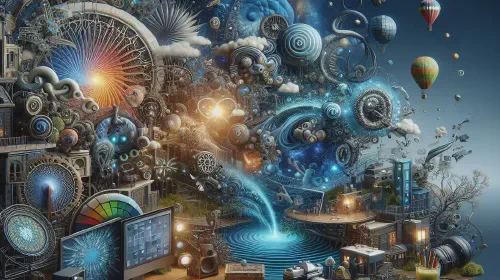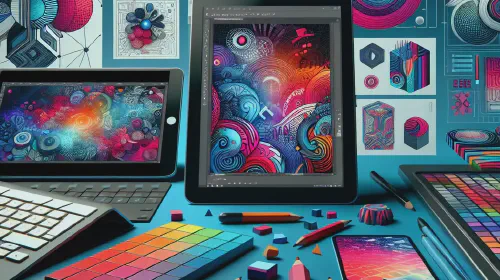Digital Art in the Commercial Sphere: Applications and Careers
Salomon Kisters
Dec 28, 2023This post may contain affiliate links. If you use these links to buy something we may earn a commission. Thanks!
In this blog post, we analyze digital art’s role in the commercial sector, focusing on practical aspects like branding and advertising. We examine how digital art is used to create effective brand images and advertisements, emphasizing its importance in engaging customers.
We also discuss the various commercial uses of digital art, from marketing campaigns to enhancing customer experiences. The article also outlines career opportunities in digital art, providing insights on the skills and pathways to success in this field.
The Role of Digital Art in Branding and Advertising
Digital art is a driving force in the modern branding and advertising landscape. It enables brands to craft unique visual identities and communicate their messages in innovative ways. Through the use of vibrant graphics, animations, and interactive elements, digital art helps create memorable brand experiences that engage consumers and foster emotional connections.
As the commercial world becomes increasingly digital, the role of digital art in marketing strategies continues to grow, offering endless possibilities for creative expression and audience engagement.
Digital Illustration for Logos
Logos are the cornerstone of a brand’s identity, and digital illustration plays a crucial role in their design. A well-crafted digital logo can convey a brand’s personality, values, and vision with just a glance. Digital artists use a variety of techniques and styles to create logos that are not only visually appealing but also versatile across different media.
From minimalist designs to intricate illustrations, digital art allows for a high level of customization, ensuring that each logo is unique and reflective of the brand it represents.
Packaging Design and Digital Art
Packaging design is another area where digital art makes a significant impact. It is the first point of physical interaction between a product and the consumer, making it a critical component of the marketing mix. Digital art allows designers to experiment with colors, textures, and shapes to create packaging that stands out on the shelves.
It also facilitates the integration of interactive elements, such as QR codes and augmented reality features, enhancing the consumer experience and adding value to the product.
Digital Artwork for Billboards and Outdoor Advertising
Billboards and outdoor advertising are traditional mediums that have been revitalized by digital art. High-resolution digital screens offer a canvas for dynamic and eye-catching visuals that capture the attention of passersby. Digital artwork for outdoor advertising can be easily updated and tailored to specific audiences or times of day, making it a flexible and cost-effective option for marketers.
The integration of digital art in outdoor advertising not only increases visibility but also allows for creative storytelling that can make a lasting impression on the audience.
Digital art is a vital component of the commercial world, enhancing branding, advertising, and marketing efforts with its creative potential and technological advancements. As the digital landscape continues to evolve, the possibilities for digital art in the commercial sector are bound to expand, offering new and exciting ways to connect with consumers.
Commercial Applications of Digital Art
Digital art has revolutionized the way we approach creativity and commerce. Its applications span across various industries, enhancing products, marketing strategies, and user experiences. Here are some insights into the commercial applications of digital art:
Enhancing User Experience with Digital Design
User Experience (UX) design is a critical aspect of digital product development that focuses on the satisfaction and ease of use for the end-user. Digital art plays a significant role in UX design by creating visually appealing interfaces that are intuitive and engaging. By improving usability, accessibility, and interactions, digital art enhances the overall experience of digital products, leading to increased customer satisfaction and business success.
In the rapidly evolving digital landscape, the success of any application or website hinges on its UX and user interface (UI) design, making digital art an indispensable tool for designers.
Digital Art in Website and App Development
In the realm of website and app development, digital art is the cornerstone of creating visually stunning and functional platforms. It encompasses everything from the layout and color schemes to the interactive elements that make a website or app not just a tool, but an experience for the user. Digital art has enabled developers to produce a wide array of media projects, including digital storytelling, animation, and game design.
With the advent of powerful digital illustration apps and software, artists and developers can now create intricate designs that are both aesthetically pleasing and user-friendly, contributing to the overall appeal and effectiveness of digital platforms.
The Impact of Digital Art on Print Media
The rise of digital art has had a profound impact on print media, transforming the way content is created and consumed. While digital media has challenged traditional print advertising revenue streams, it has also provided new opportunities for print media to evolve. Digital art has enabled the creation of digital prints and has influenced the visual emphasis in print media as a response to the digital environment.
The integration of digital art into print media has led to innovative approaches that combine the tactile nature of print with the dynamic capabilities of digital tools, offering a fresh perspective on traditional media.
Digital art is a versatile and powerful tool that has found its way into various commercial applications, from enhancing user experiences to redefining traditional print media. Its influence continues to grow as technology advances, opening up new possibilities for creativity and commerce alike.
Career Paths in Digital Art
The digital art industry offers a plethora of career paths for those with a passion for creativity and technology. Digital artists can find themselves working on a wide array of projects, including video animation, website design, video game development, and more. The field encompasses various roles such as graphic designers, motion designers, web designers, multimedia designers, and visual effects artists.
With the rise of digital media, the demand for skilled professionals in this sector is growing, providing a promising outlook for aspiring digital artists.
Motion Graphics Animator: A Creative Career Choice
Motion Graphics Animators, also known as MoGraph professionals, are responsible for creating animation and visual effects for media such as television, film, and online content. They combine graphic design with animation to produce dynamic and engaging visuals that tell a story or promote products and services. The role requires proficiency in animation software and a strong understanding of design principles.
The job outlook for special effects artists and animators is projected to grow, with opportunities available in various industries, including entertainment and advertising.
Videographer: Capturing the Digital World
Videographers are skilled professionals who record live events and produce small-scale video productions, such as documentaries, corporate videos, and special events coverage. They are adept at handling camera equipment, sound recording, and video editing. The career can be both rewarding and lucrative, with opportunities to work on television sets, weddings, and even film production.
Social Media Designer: Crafting Online Identities
Social Media Designers specialize in creating visually appealing and engaging content for social media platforms. They blend graphic design with marketing strategies to enhance a brand’s online presence and connect with target audiences. Responsibilities include designing posts, pages, and advertisements that resonate with viewers and drive online traffic. Social Media Designers must stay current with digital trends and possess a keen eye for design.
With the ever-growing importance of social media in business, the demand for skilled designers in this area is on the rise, offering numerous job opportunities and the potential for creative fulfillment.
Building a Career in Digital Art
To build a career in digital art, professionals need to develop a combination of artistic and technical skills. Basic drawing skills are essential, and exposure to various media can be beneficial. Proficiency in design, painting, and animation skills (both 2D and 3D) is often required. Coding skills may also be necessary, especially for roles that involve interactive media or game design.
Education can play a significant role in acquiring these skills. While formal education is not always mandatory, many digital artists benefit from certificates or degrees in graphic design, illustration, 3D modeling, or similar fields. Continuous practice in shading, lighting, and digital painting is crucial for honing one’s craft. Programs dedicated to digital art and animation provide both academic knowledge and hands-on training to succeed in the industry.
Identifying a niche within the digital art industry can help artists stand out and cater to specific market demands. A niche could be a particular medium, such as digital painting, 3D printing, or animation. To find your niche, analyze the market, define your message, examine your competition, and consider your interests and strengths. It’s important to become a specialist in your chosen area, which can involve creating a portfolio that showcases your unique style or thematic focus.
Networking and marketing are key components of a successful digital art career. Artists must strategically promote their work to reach their target audience. This can involve creating a strong portfolio that includes published work, personal projects, commissions, and fan art. Utilizing digital tools and social media platforms is essential for reaching a wider audience.
However, networking extends beyond online presence; attending industry events, participating in art shows, and connecting with other professionals can lead to valuable opportunities.
Marketing oneself effectively involves understanding the art market, developing a personal brand, and learning how to run a business aspect of being an artist. It’s important to use a mix of strategies, including social media management, digital marketing, and event participation, to build a reputation and attract clients or employers.
By combining artistic talent with strategic marketing and networking efforts, digital artists can create a sustainable and fulfilling career in the ever-evolving digital art industry.
The Future of Digital Art in Commerce
The future of digital art in commerce is being shaped by innovative partnerships and the integration of technology into traditional art markets. For instance, the collaboration between Ledger and Sotheby’s signifies a commitment to securing the future of digital art by providing a platform for its authentication and sale. This partnership is a testament to the growing importance of digital art in the commercial sphere and its potential to redefine the art market.
Digital art is increasingly becoming intertwined with commerce as the physical and digital worlds merge. Companies are leveraging digital art to enhance their marketing strategies and consumer engagement. The rise of e-commerce has also facilitated the growth of the online art market, with more people turning to digital platforms to purchase art.
This shift is indicative of a broader trend where digital art is not only appreciated for its aesthetic value but also recognized as a viable investment.
Emerging Trends in Digital Art
Emerging trends in digital art are diverse and dynamic, reflecting the rapid evolution of technology and its creative applications. Some of the notable trends include fractal art, 3D hyper-surrealism, digital destruction, experimental typography, and NFT art. These trends are shaping the digital art landscape, offering new ways for artists to express themselves and for audiences to engage with art.
The Role of Technology in Shaping Digital Art Careers
Technology plays a pivotal role in shaping the careers of digital artists. It provides the tools and platforms necessary for artists to create, share, and monetize their work. The internet and social media have become indispensable for marketing and networking, allowing artists to reach a global audience.
Creative technology, which involves the use of innovative digital tools, is opening up new career paths in industries that blend art with technology. Digital transformation is also influencing education, with online courses and resources making it easier for aspiring artists to learn and develop their skills.
As technology continues to evolve, it will undoubtedly create more opportunities for digital artists to forge successful careers in a variety of fields, from entertainment to advertising, and beyond. The digital art landscape is one that is constantly being reshaped by technological advancements, making it an exciting time for artists to explore and innovate.
Conclusion: The Expanding Horizon of Digital Art in Commerce
As we conclude our exploration of digital art in the commercial world, it’s clear that its influence is far-reaching and its potential boundless. Digital art has not only revolutionized branding and advertising but has also opened up new avenues for artists to pursue fulfilling careers. It’s a domain where creativity meets technology, resulting in a synergy that propels both commerce and art forward.
The future of digital art in the commercial sector is bright, with emerging trends and technological advancements paving the way for even more innovative applications. As digital art continues to intertwine with commerce, it promises to bring about a new era of artistic commerce, one where the beauty of art and the efficiency of business coalesce to create experiences that resonate with consumers on a deeper level.
The canvas of the commercial world awaits the next stroke of digital brilliance, and we can only anticipate the masterpieces that will emerge from this dynamic and ever-evolving art form
Stay informed with the latest insights in Crypto, Blockchain, and Cyber-Security! Subscribe to our newsletter now to receive exclusive updates, expert analyses, and current developments directly to your inbox. Don't miss the opportunity to expand your knowledge and stay up-to-date.
Love what you're reading? Subscribe for top stories in Crypto, Blockchain, and Cyber-Security. Stay informed with exclusive updates.
Please note that the Content may have been generated with the Help of AI. The editorial content of OriginStamp AG does not constitute a recommendation for investment or purchase advice. In principle, an investment can also lead to a total loss. Therefore, please seek advice before making an investment decision.

The World of Digital Art - Categories and Techniques
Discover the tools, techniques, and innovative processes behind digital painting, animation, and more, as artists push the boundaries of traditional art using digital canvases.

Understanding Digital Art - Forms and Styles
Explore the vibrant realm of digital art and its fusion with technology. Discover the diverse styles and innovative potential that redefine artistic expression in the digital age.

Who Runs Ethereum? Understanding Decentralized Governance
Ethereum has a decentralized governance model, with stakeholders like Ether holders, developers, and miners contributing to decision-making.
Protect your documents
Your gateway to unforgeable data. Imprint the authenticity of your information with our blockchain timestamp